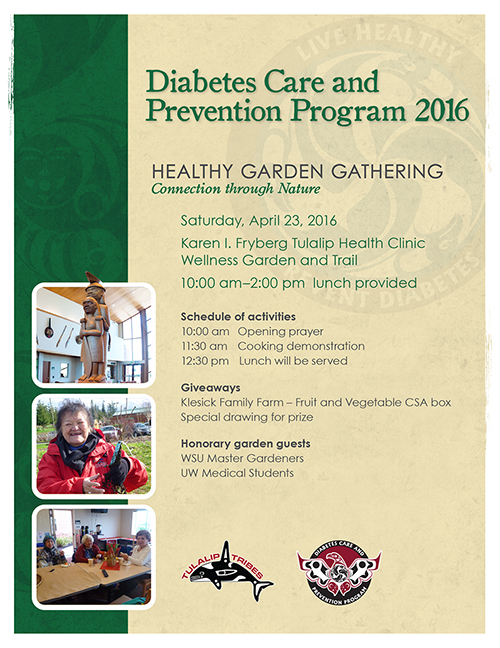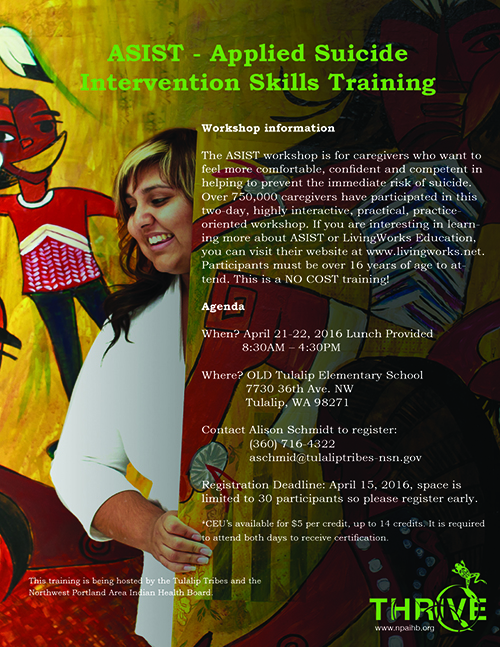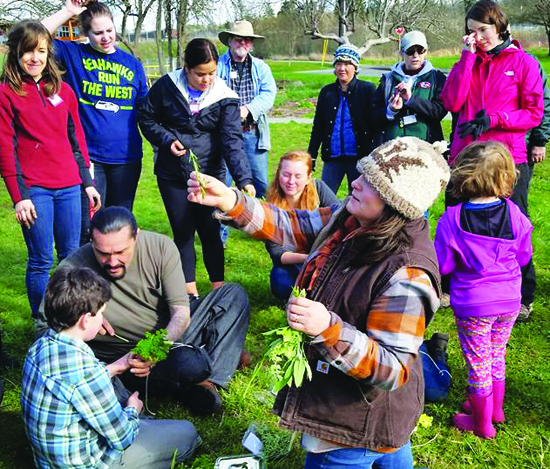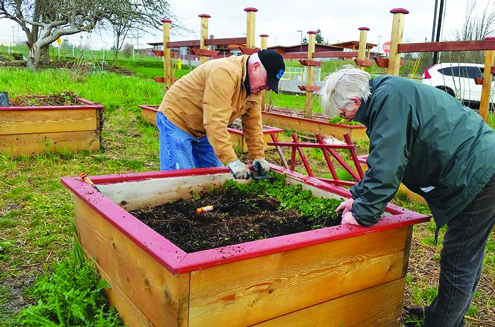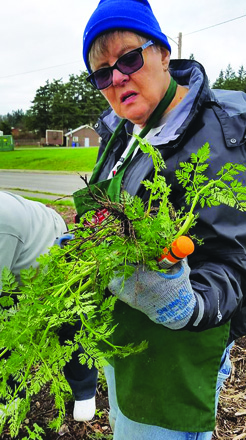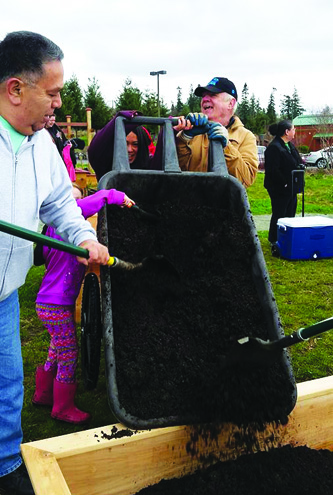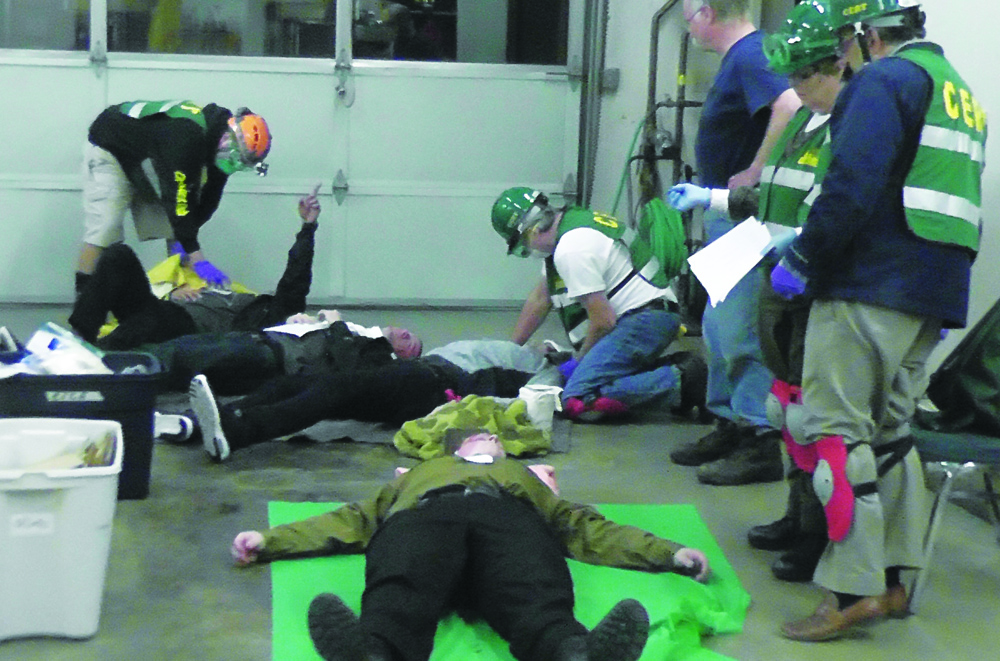Garden Gathering Saturday, April 23 in collaboration with Tulalip Tribes Natural Resources Department and the Snohomish County Conservation District. Events begins at 10am at the Karen I Fryberg Tulalip Health Clinic and includes a brief discussion on rain barrels and master gardeners will be on hand to answer questions about your own gardens. There will be a giving away of vegetable starts from the greenhouse.
Category: Health
ASIST: Applied Suicide Intervention Skills Training, April 21-22
Healthy Hearts, Healthy Minds
By Micheal Rios, Tulalip News
Amongst Native peoples, few things in life are as scary as diabetes. And then, after being clinically diagnosed with diabetes, a person must take many steps to resume a normal life, and in most cases, a more healthy lifestyle. What can be just as surprising as the diabetes itself are the unexpected, nonphysical effects, which are equally threatening to one’s quality of life. Although these effects might make the road to diabetes management somewhat bumpy, experts from the Healthy Hearts team from the University of Washington’s Indigenous Wellness Research Institute are demonstrating that life with diabetes not only goes on, but can get better.
The Healthy Hearts team has been working to understand and address cardiovascular disease in the Tulalip community since 2008. The first study, Healthy Hearts Across Generations, collected surveys from 284 randomly selected participants from the Tulalip tribal membership to examine cardiovascular disease risks and look at what coping strategies were most productive. From 2010 to 2012, Healthy Hearts Across Generations also provided 135 community parents and guardians with culturally influenced classes to promote health in their families.
In 2012, planning began for the second Healthy Hearts study called Healthy Hearts, Healthy Minds. This was launched in 2013 for Natives in the Tulalip area whose diabetes/prediabetes put them at greater risk for heart disease. Healthy Hearts, Healthy Minds provided those who were eligible and wanted to participate with one-on-one wellness counseling to take control of their diabetes self-care. This study came to a close in late February.
Local community resources and input from tribal members were used to develop study materials and programs, which were culturally-adapted and designed to promote sticking with positive, healthy behaviors even when it can be tough in the face of busy schedules and other challenges.
Just as exercise strengthens the mind as well as the body, awareness and education play an important role in nonphysical healing. Optimal diabetes management is more likely when people understand the nature and persistence of diabetes, and the fact that it is treatable. It’s more than just sharing facts; people also must be taught how to return to healthier lifestyles and avoid the habits that likely contributed to their health issues in the first place. This is yet another way in which wellness counselors are beneficial, providing an evidence-based intervention strategy to help participants succeed with diabetes management.
“Our focus was the wellness mental state. With diabetes, one of the challenges is that you are asked to do so many things to take care of it yourself. You have to change how you eat, you have to exercise, and check your blood sugar, you have to take your medicine, and don’t forget about getting your eyes and feet checked. It becomes very overwhelming for people,” says Rachelle McCarty, Project Manager of Healthy Hearts, Healthy Minds. “If you are really stressed out, then it’s hard to take care of yourself. That’s where our program aimed to help out. We provided participants with one-on-one coaching and very useful tools and information, so they could minimize their stress level to better manage their diabetes.”
Participants were asked to meet with a wellness coach for 10 sessions over a three-month period. Throughout the sessions, participants worked with their wellness coach to identify individual goals they wished to focus on regarding their pre-diabetes or diabetes and stress. They also worked with their coach to complete the Healthy Hearts, Healthy Minds curriculums, which covered a range of topics and skills like problem-solving, adherence, motivation and relaxation training.
Wellness coach Michelle Tiedeman, who has been with Healthy Hearts since 2009, says “What I enjoyed the most was working one-on-one with individuals and seeing them make one small, positive change at a time that added up to better overall wellness. It has been an honor to work with the Tulalip community the past several years. I have had the pleasure to work with some amazing individuals and see them accomplish great things.”
Healthy Hearts sponsored an informational lunch to share results from Healthy Hearts Across Generations in August 2014, and hosted a community celebration on February 2, 2016 to honor Tulalip’s commitment to health and share results from Healthy Hearts, Healthy Minds. You may have also seen them giving out results flyers and booklets at public events, health fairs, and the semi-annual General Council meeting last year.
Here is a sample of some of the findings:
- 42% of tribal members who responded to the health survey said they do participate in traditional activities like culture night, canoe journey, salmon ceremony, talking circles, and others.
- 40% of tribal members who responded to the health survey reported that they had high blood pressure, 50% of the men and 32% of the women.
- 27% of parents reported that they often use their own behavior as an example to encourage their child(ren) to be physically active.
- 77% shared that they have one or more blood (biological) relatives with diabetes.
- Those who enrolled in Healthy Hearts, Healthy Minds significantly lowered their depressive symptoms.
- Healthy Heart, Healthy Minds participants rated themselves significantly better at sticking with their goals at the end of the program compared to the beginning.
- 70% agreed with the statement, “I have a responsibility to walk in a good way for future generations.”
For help with your diabetes, contact the Diabetes Care and Preventions Program at 360-716-5642. For more information on the projects or results available to date, email the Healthy Hearts, Healthy Minds study at iwri@uw.edu. The projects were funded by the National Heart, Lung and Blood Institute, and the National Institute on Minority Health and Health Disparities.
Contact Micheal Rios, mrios@tulaliptribes-nsn.gov
Healthy food and healthy community are key to diabetes prevention
By Niki Cleary, Tulalip News
Exercise, laughter and hugs, fresh air and a sense of accomplishment were some of the gifts about 50 community members gave themselves on Saturday, February 20. The Healthy Gardening Gathering, hosted by the Karen I. Fryberg Health Clinic’s Diabetes Care and Prevention Program, was much bigger than a seminar on gardening and preparing healthy meals; it was a reminder that peer pressure can be a good thing. The effort, which involved preparing new garden beds for the Clinic gardens, more importantly provided a place to build fellowship and support for wholesome living.
Members of the WSU Master Gardeners program were onsite to offer their knowledge and enthusiasm about gardening. Many of the volunteers who joined in have worked with each other before, some have helped out at the Hibulb gardens, some are part of the Diabetes Prevention Program, others participate in the Wisdom Warriors program. Their common ground (pun intended) is a desire to live well and enjoy life.
Toddlers, elders and all ages in between joined the fun. If you are interested in learning to garden, if you want to eat healthier and exercise more, or if you’re just looking for some fun people to hang out with email Veronica Leahy for more information vleahy@tulaliptribes-nsn.gov.
Coming up, the Diabetes Program has two field trips, one for a Padilla Bay nature walk on March 11, and one for a Heronswood nature walk and plant sale, April 2. Upcoming classes and education include Diabetes Day March 3, a set of Diabetes comprehensive classes March 9, 16, 23 and 30. Additional gardening opportunities will be available at the Clinic gardens April 16 and June 11, and at the Hibulb Gardens March 5 and 12.
CERT is Offered Again at Tulalip
by Sandy Evans, RN, MPH, Tulalip Tribes Preparedness/MRC/CERT Volunteer Coordinator
Disasters can strike at any time and being prepared for these and other unexpected events is critical to saving lives. Each one of us has a responsibility to understand the risk natural and man-made disasters pose to our communities, and to recognize we each have a role in preparing for these events. We have a duty to build a Culture of Preparedness in which our neighbors, families and friends are ready for any disaster event, and to make our communities safer, stronger, and better prepared.
The Community Emergency Response Team (CERT) concept was developed and implemented by the City of Los Angeles Fire Department in 1985. They recognized that people will likely be on their own during the early stages of an emergency or disaster. Accordingly, the fire department decided that some basic training in disaster survival and rescue skills would improve the ability of people to survive until responders or other assistance could arrive. For 30 years CERT trainings have taken place across the U.S., even here on the Tulalip Reservation several years ago. Our pilot program in 2015 successfully graduated 9 participants and finished on November 19th, during a storm-caused power outage! Recognizing the value of this program the Tulalip Tribes Office of Emergency Management and Volunteer Preparedness Team is again offering CERT classes to our community.
CERT Basic Training is a free, instructor-led course consisting of over 20 hours of instruction on topics such as Personal and Family Preparedness, Earthquake Preparation, Team Organization, Medical Operations and Triage, Damage Assessment, Fire Suppression, Utility Control and Light Search & Rescue that can provide you will the skills you will need to stay safe and resilient during a disaster or emergency.
Our next CERT training will be held at the Administration building in the mornings from eight to noon for five sessions over 2 weeks. Each class will last 4 hours. The dates are Tuesday & Thursday March 15 and 17, Tuesday, Thursday and Friday March 22, 24 & 25. Because this is during usual work hours, supervisor permission is required and participants will be expected to attend all 5 sessions, establish a three (3) day home survival kit, obtain personal safety equipment, and be a willing team participant. CERT is about people helping people.
If you are interested in taking this course, ask your supervisor if you can get this time off and request an application/release form at Tulalip CERT (tulalipcert@tulaliptribes-nsn.gov).
What Is Whooping Cough And How Can I Take Care Of My Child?
Whooping Cough (Pertussis) |
What is whooping cough?
Whooping cough is a lung infection. It is called whooping cough because of the whooping sound of your child’s breathing after a coughing spell. It is also called pertussis.
Adults can usually recover from whooping cough, but it is a very dangerous disease for babies. Complications of whooping cough can include pneumonia, seizures, and death.
What is the cause?
Whooping cough is caused by bacteria called Bordetella pertussis. Children can get infected by breathing in the bacteria from someone who is sneezing or coughing. When teens or adults have whooping cough, it’s usually a mild cold-like illness, so they don’t know they are carrying the bacteria and able to pass it on to babies and children.
What are the symptoms?
The first symptoms are usually a runny nose, mild cough, and pink eyes. The cough may last for a few weeks. The younger your child is, the more severe the infection is likely to be. The cough can get worse and worse. It may cause vomiting. Your child’s face may turn red or blue. Coughing spells are usually worse at night. Babies may have spells of not breathing.
How is it diagnosed?
Your healthcare provider will ask about your child’s symptoms and medical history and examine your child. Your provider may get a sample of mucus from your child’s nose to test for bacteria.
How is it treated?
Your child’s healthcare provider will prescribe antibiotic medicine. The medicine may decrease the severity of the illness, but will not cure it immediately. Because whooping cough is a very serious illness for babies, they may need to stay at the hospital for treatment.
Everyone in close contact with your child will be asked to take an antibiotic to keep them from getting sick or passing the bacteria to others. This includes the people your child lives with and child care providers.
How can I take care of my child?
- If the air in your child’s bedroom is dry, a cool-mist humidifier can moisten the air and help make breathing easier. Be sure to follow the manufacturer’s instructions for cleaning the humidifier often so that bacteria and mold cannot grow. You can also try running hot water in the shower or bathtub to steam up the bathroom. If your child is coughing hard or having trouble breathing, have your child sit in the steamy bathroom for 10 to 15 minutes.
- Gentle suction with a bulb syringe may be used to remove mucus. Saline water may help thin mucus in the nose and throat so it is easier to remove.
- Do not give cough medicines to children under the age of 4. If your child is between the ages of 4 and 6, ask your healthcare provider before giving cough medicine. For children over the age of 6, you can give cough medicines, but they have not been proven to be helpful.
- Honey has been shown to help coughs but should not be given to children under 1 year because of the risk of botulism.
- Encourage your child to drink lots of plenty of liquids to help loosen mucus and make it easier to cough it up. Fluids can also help your child breathe easier.
- Make sure your child gets plenty of rest.
- Keep your child away from things that trigger coughing, such as smoke, perfumes, or pollutants.
- Follow your child’s healthcare provider’s instructions. Ask your provider:Make sure you know when your child should come back for a checkup. Keep all appointments for provider visits or tests.
- How and when you will hear your child’s test results
- How long it will take for your child to recover
- If there are activities your child should avoid and when your child can return to normal activities
- How to take care of your child at home
- What symptoms or problems you should watch for and what to do if your child has them
How can I help prevent whooping cough?
The pertussis vaccine protects against whooping cough and is included in children’s DTaP shots, starting at 2 months of age. Babies should get 3 DTaP shots during their first year of life, followed by booster shots as they get older.
Whooping cough is a very dangerous disease, and can cause death for babies. The DTaP vaccine is very safe and effective in preventing this disease. The risk of having problems or long-term damage from the pertussis vaccine is very low. Your child’s healthcare provider will discuss any possible side effects with you.
A tetanus-diphtheria-pertussis booster called a Tdap shot should be given at age 11 or 12. Adults or teens who did not get a booster shot at this age should get a Tdap shot one time, especially if the family is expecting a baby. Anyone in close contact with babies should be up-to-date with whooping cough vaccination.
Developed by RelayHealth.
Published by RelayHealth.
This content is reviewed periodically and is subject to change as new health information becomes available. The information is intended to inform and educate and is not a replacement for medical evaluation, advice, diagnosis or treatment by a healthcare professional.
For any questions or concerns, don’t hesitate to call your provider at the Karen I Fryberg Tulalip Health Clinic at 360-716-4511.
Birthing Class, February 24
Health Alert: New Flu Cases at Karen I. Fryberg Health Clinic
Submitted by Anneliese Means, RN, BSN, Community Health Nurse
The flu viruses have arrived in Tulalip but it’s not too late to vaccinate – Get your flu vaccine today!
This week at the Tulalip Health Clinic we diagnosed and treated three children with the flu under the age of seven. Unfortunately it is our children, elders (over the age of 50), and our pregnant women who are at high risk of having flu related complications (like severe illness, hospitalization, and even death). The flu season could stretch all the way into May this year so it is not too late to vaccinate!
For millions of people every season, the flu can mean a fever, cough, sore throat, runny or stuffy nose, muscle aches, fatigue, and miserable days spent in bed. However, you may not realize that each flu season, flu also causes hundreds of thousands of hospitalizations, and thousands or sometimes tens of thousands of deaths.
How dod I know if I have the flu?
If you have a fever, cough, sore throat, runny or stuffy nose, muscle aches, or fatigue you might have the flu.
What can I do?
Prevent the flu by getting your flu vaccination, covering your cough, and regularly washing your hands (for 30 seconds or more).
When you are sick, wash your hands, cover your cough, stay away from loved ones, and go to the doctor quickly to be checked for the flu.
Studies show that flu vaccination can reduce flu illnesses, doctors’ visits, missed work and school due to flu, as well as prevent flu-related hospitalizations. This is why CDC recommends an annual flu vaccine for everyone 6 months and older (including pregnant women). Flu vaccines are available at the Tulalip Health Clinic as a shot and as a nasal spray through a walk-in nurse visit for vaccination.
Karen I. Fryberg Health Clinic (360-716-4511)
Nurse Visit/Vaccination Walk-In Days:
Monday, Tuesday, Thursday, and Friday
Hours: 8am-11:30am and 1pm-3:30pm
Wednesday
Hours: 10am-11:30am and 1pm-4pm
To learn more about high risk conditions, visit http://www.cdc.gov/flu/about/disease/high_risk.htm
Parenting: The Love and Logic Way, February 18
Life is the best gift of all
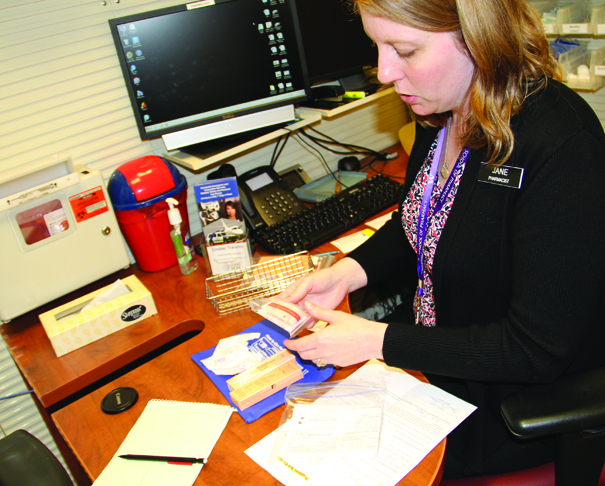
Photo/Niki Cleary
by Niki Cleary, Tulalip News
It’s the time of year that we gather together with our family, reminisce about favorite memories and create new ones. While the holidays are a time of love and generosity, for those down on their luck they can be a painful reminder of better times. Holidays can also bring the added stress of creating the perfect holiday experience (usually accompanied by consumer debt) and they can heighten emotions grief and loss. Many cope with the stress and pain by leaning on prescription drugs or opiates.
Too often deaths in our community are a result of drug overdose. According to a report released early this year, one out of every five heroin deaths in the State occurred in Snohomish County (you can view the report http://www.snohd.org/Records-Reports/Data-Reports). Combined with the fact that drug use spikes during the holidays, chances are someone you know may be in danger of opiate overdose this season.
Other than abstinence, there’s no surefire way to prevent overdose, and the stigma surrounding addiction often prevents people from being willing to even discuss the possibility of a family member’s use or potential overuse of drugs. Tulalip citizen Rico Madison lost his mother to an opiate overdose; the experience has made him passionate about changing the culture of hiding drug addiction.
“I do this because everybody has someone close to them,” he said. “Everyone has been in a situation where they rejected someone who asked for help, or someone they wish they could have helped.”
One of the primary tools to offset the harm of drug addiction is Narcan, also known as Naloxone.
“Narcan is a way to help without enabling,” Rico continued. “It’s like a fire extinguisher, it can’t hurt, it can only help.”
Rico campaigns constantly to encourage everyone to purchase a Narcan kit. Most insurances will cover at least part of the cost.
The simple explanation of a deadly opiate overdose is that the effects of opiates cause your brain to shut down the normally automatic impulse to breathe. Without oxygen to the body, the heart stops and brain damage and death follow. Narcan is a narcotic antagonist; it blocks opiate receptors, which can temporarily halt the effects of the opiate.
Tulalip Pharmacist Jane Jacobson explained, “This is not a fix, it’s a last resort. A dose will wear off in 30-90 minutes, so you still need to call 911, because when it wears off the patient will be back into overdose.”
She described the ‘look’ of an opiate overdose, “They may look like they’re sleeping. They may be breathing very slowly. They may breathe in a long, slow gasp, followed by a long pause. They may have blue or gray lips or may be unresponsive. When a person is only breathing 5-10 breaths a minute, you are looking at brain damage.
“If you even think someone may be overdosing on opiates administer Narcan immediately,” she instructed. “It only works on opiates, if someone is overdosing on something else, this won’t hurt them. There are two doses in your kit. If there’s no effect within two to three minutes, use the other syringe, start rescue breaths and call 911.”
Due to Rico’s activism, Tulalip enacted the Lois Luella Jones Good Samaritan Law, a law that offers limited exemption from prosecution if a person calls 911 for help with an overdose.
“With the Good Samaritan Law you will not be arrested for drug paraphernalia, underage drinking, or non-violent misdemeanors,” explained Jane. “Sometimes addicts want to help, but they don’t call 911 because they’re afraid they will be arrested.”
Narcan kits are available at the Tulalip Pharmacy. Tulalip employee insurance covers the cost with only $8.00 co-pay, and Washington’s Applecare covers the kits at 100%. For the uninsured, the kits cost $105 for non-Tulalips and $65 for Tulalip citizens.
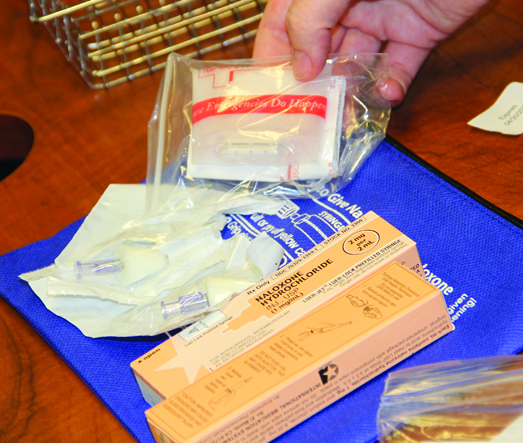
Photo/Niki Cleary
“We have a lot of kits in stock, made up and ready to go,” said Jane. She pointed out that the kits, while generally sought after by families and friends of those suffering addiction, are useful for many populations.
“We also recommend people on chronic pain management medications have kits on hand as well,” she said. “Hopefully you won’t need it, but it’s here if you do. It’s better to have a kit just in case than be in a situation where you could have used it and saw a friend or family member pass away when you could have gotten something to save them.”
If you have a kit and use one dose, replace it even though there’s another dose still in the kit.
“You always want the second dose,” said Jane, reminding that sometimes a single dose isn’t enough to halt the overdose. Each kit comes with a pharmacist’s consultation and purchasers watch a video to explain how to use it. Narcan is prescribed as a four-day supply, so a client can pick up a new kit every four days if they choose.
“If people want to come in and get kits as a family, we can do that too,” said Jane.
“I don’t want to go to another funeral because of overdose,” said Rico. “I want people to understand that it’s easy, it’s the difference between life and death and it only takes 20 minutes.”
A fire extinguisher, a life preserver, a first aid/CPR class; we don’t think twice about most tools designed to save lives. If you can learn something or buy something and save someone’s life, it’s a no-brainer, right? Narcan is no different. This holiday season, while you’re shopping and heading to and from dinners and holiday parties, please think about scheduling a trip to the Tulalip Pharmacy to pick up a Narcan kit. It may be that the greatest gift you give this year, is saving someone’s life.

